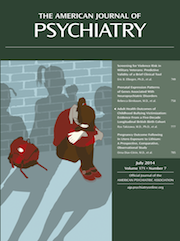Response to Pinta
To the Editor: We are grateful to Dr. Pinta for his interest in our article. However, we would caution against drawing conclusions from our study about the relative effectiveness of continuing treatment in the community for prisoners with schizophrenia following release and providing treatment only during prison.
Our results are indeed suggestive of no additional beneficial effects on violence conveyed by continuing treatment, an attractive proposition in terms of cost savings. However, this was an observational longitudinal study and it was not designed to provide definitive information on treatment effectiveness, which could only be determined by a randomized controlled trial.
What we can confidently conclude is that the effects of not treating prisoners with schizophrenia during or after imprisonment results in the emergence of persecutory delusional beliefs, which in turn lead to an increased prevalence of violence in this subgroup. Given that their delusion-driven violence occurred following release, it is entirely logical to promote community-based treatments for such individuals. However, larger studies with longer follow-up periods are required to test this hypothesis.
Our study should not be considered a comparison of the efficacy of different treatments, but rather as the identification of a significant public health problem with implications for violence prevention and public safety.



